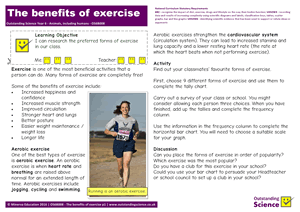

I can describe the functions of blood and blood vessels.
Children describe the functions of red blood cells, white blood cells, platelets and plasma, and create a pie chart showing the percentage of each component by volume in a typical sample of blood.
I can identify the main parts of the human circulatory system and explain their functions.
They learn about the role of the heart, blood vessels, and the components of blood such as red and white blood cells, platelets and plasma. In the writing frame provided, children create an information text on the human circulatory system using what they have learned.

2 pages
I can explain how the human heart works.
Children create their own 8-part explanation text, showing how blood is pumped around the body. They cut and paste, or write their own descriptions.

3 pages
I can investigate the effect of exercise on heart rate.
Children learn to measure their heart rate in beats per minute (bpm) by taking their radial pulse. They take and record their resting heart rate, then perform a vigorous exercise and measure their heart rate afterwards at an interval of 1 minute for 8 minutes. Children record their results in a table and transfer them to a line graph. Children interpret their results, discussing how their heart rate changed over time and why.

2 pages
I can calculate how much alcohol is in different alcoholic beverages.
Children learn about the short and long-term effects of alcohol consumption. Children look at 16 different servings of different alcoholic drinks. Using the serving size and %ABV, they calculate how much alcohol (in ml) and how many units of alcohol are in each beverage. They place the beverages in order of strength. Children discuss why people drink alcohol if it has negative health effects.

3 pages
I can describe the effects of smoking.
Children carry out a survey, using a tally chart to find out the worst side effect of smoking. They transfer their results to a bar chart and place the negative effects in order of concern.

4 pages
I can explain how diet and exercise affect body weight.
Children look at 6 different people profiles. They calculate whether each person is eating the right amount of food, and suggest ways in which they can improve their lifestyles.

4 pages
I can research the preferred forms of exercise in our class.
Children learn about the many benefits of physical exercise, and identify some aerobic exercises. Children carry out a survey, identifying the most popular forms of exercise in their class or school. They record their results in a tally chart, displaying their results in a horizontal bar chart. They identify the most popular forms of exercise and suggest ways in which they can be promoted in school.

3 pages